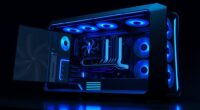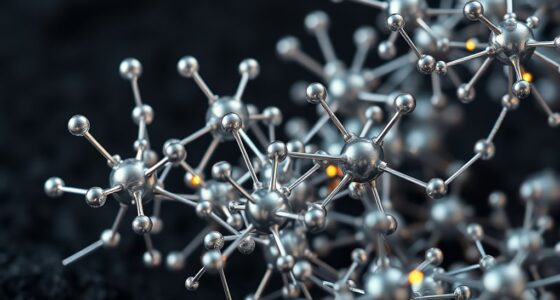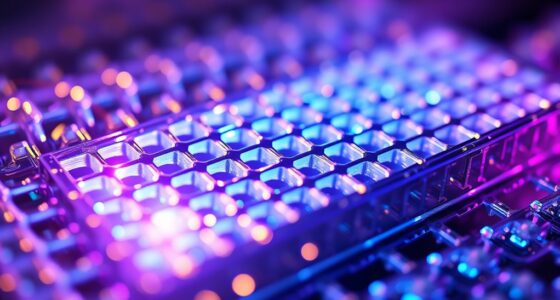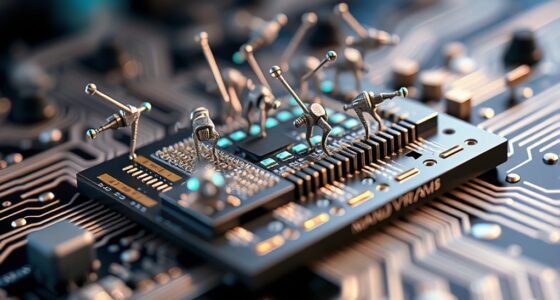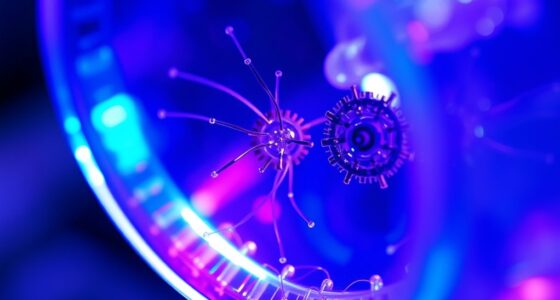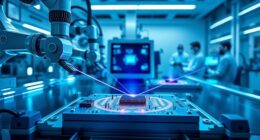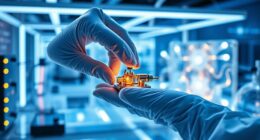Self-repairing nanomachines use molecular communication, sensors, and materials like self-healing polymers to detect damage and initiate autonomous repairs at the nanoscale. They rely on mechanisms such as reversible bonds and self-assembly, guided by embedded sensors and control systems, to maintain functionality. Challenges include ensuring stability in complex environments and addressing safety concerns. Exploring these concepts further will reveal how these innovations aim to transform industries and improve system resilience over time.
Key Takeaways
- Self-repair in nanomachines utilizes molecular communication and autonomous molecular interactions for damage detection and structural reassembly.
- Quantum coherence and sensing enhance repair precision, stability, and control amid environmental disturbances at the nanoscale.
- Material strategies include self-healing polymers, reversible bonds, and embedded healing agents for autonomous damage sealing.
- Challenges include environmental factors, manufacturing variability, safety concerns, and ensuring long-term reliability and robustness.
- Future advancements focus on integrating quantum effects, machine learning, and biocompatible materials for smarter, more autonomous nanorepair systems.
Fundamental Principles of Self-Repair in Nanotechnology
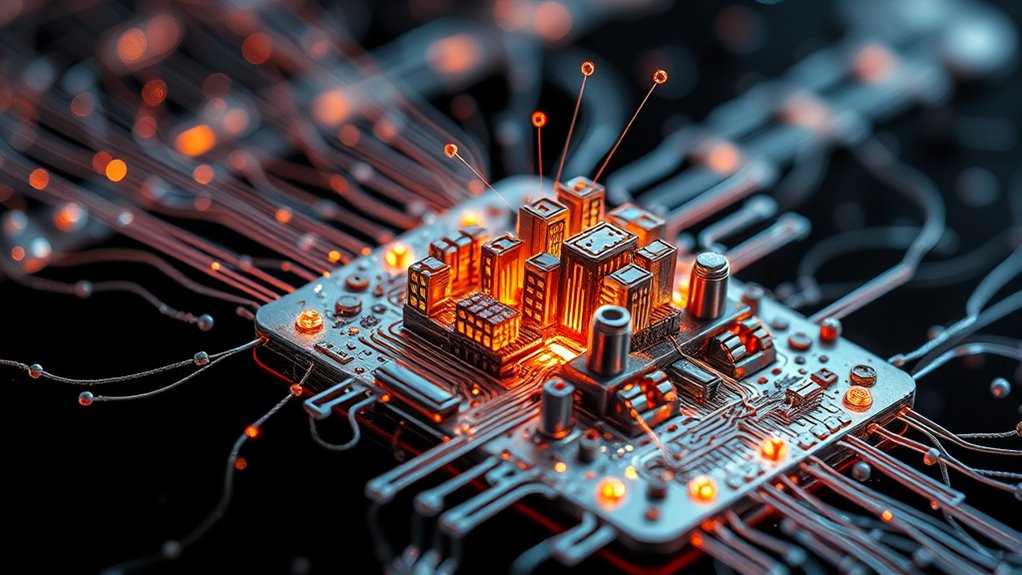
Have you ever wondered how nanomachines can fix themselves? It all starts with understanding the fundamental principles behind self-repair. Molecular communication plays a critical role, enabling nanomachines to detect damage and signal repair processes at a tiny scale. These machines rely on molecules acting as messengers, coordinating responses precisely where needed. Quantum coherence also contributes, allowing nanomachines to maintain and transfer quantum states that improve their stability and function during repairs. This coherence helps guarantee accurate communication and control, even amidst environmental disturbances. Additionally, advancements in projector technology are providing insights into complex systems that can be applied at the nanoscale. By harnessing molecular signals and quantum effects, nanomachines can identify faults, initiate repairs, and restore their functions. These principles lay the groundwork for developing reliable, autonomous self-healing systems at the nanoscale.
Designing Self-Healing Mechanisms for Nanosystems
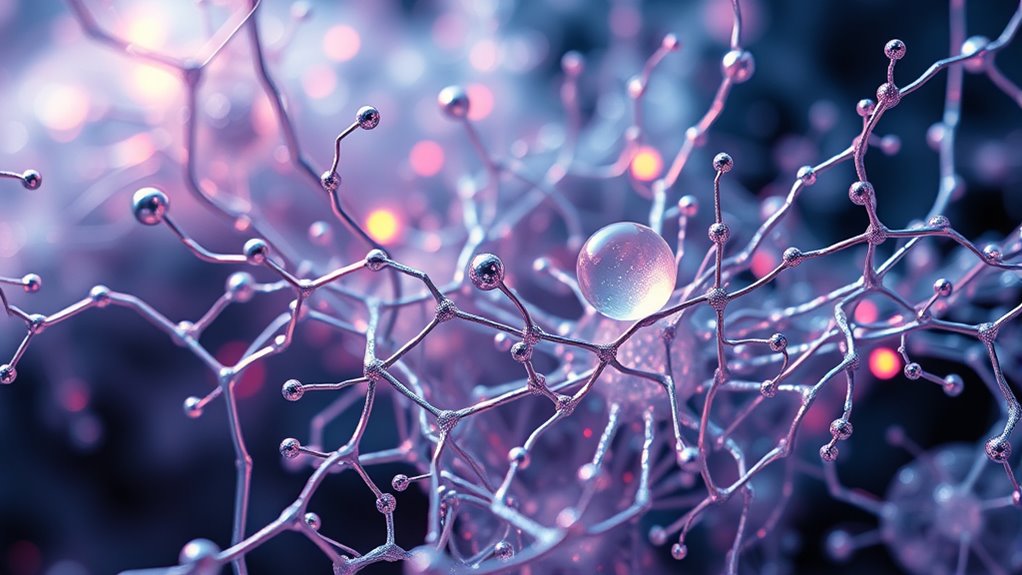
When designing self-healing mechanisms, you need effective material repair strategies that respond quickly to damage. Autonomous damage detection allows the system to identify issues without external input, ensuring reliability. Incorporating self-assembly processes helps nanosystems rebuild themselves seamlessly, maintaining functionality over time. Additionally, selecting appropriate coating technologies can enhance the durability and responsiveness of self-healing materials.
Material Repair Strategies
Designing self-healing mechanisms for nanosystems requires innovative material repair strategies that enable nanomachines to autonomously detect and mend damage. One approach involves using biocompatible coatings that protect sensitive components while allowing self-repair processes to occur without toxicity. These coatings can incorporate reversible bonds or self-healing polymers that respond to cracks or wear. Additionally, energy harvesting plays a crucial role, providing the necessary power for repair activities. By integrating nanogenerators or piezoelectric materials, your nanomachines can convert environmental energy into electrical energy, fueling self-healing functions. Combining biocompatible coatings with energy harvesting techniques ensures durability and sustainability of nanodevices, minimizing maintenance needs. These material repair strategies are pivotal for advancing resilient, autonomous nanomachines capable of long-term operation in complex environments.
Autonomous Damage Detection
To enable nanomachines to repair themselves effectively, they must first detect damage automatically. Quantum sensing allows for ultra-sensitive detection of structural changes at the atomic level, providing real-time damage alerts. Energy harvesting enables nanomachines to power sensors without external inputs, ensuring continuous operation. By integrating these technologies, you create a self-sufficient system capable of early damage detection. The following table highlights key detection strategies:
| Technique | Key Advantage |
|---|---|
| Quantum sensing | High precision, atomic-scale detection |
| Piezoelectric sensors | Mechanical stress detection |
| Optical sensors | Rapid response, non-invasive |
| Chemical sensors | Detects corrosion or material degradation |
| Energy harvesting | Sustains sensor operation autonomously |
This combination guarantees your nanosystem remains vigilant, enabling timely self-healing responses.
Self-Assembly Processes
Self-assembly processes enable nanosystems to autonomously form and repair their structures by harnessing specific molecular interactions. You can design mechanisms where molecules communicate through molecular communication channels, guiding repair and assembly at the nanoscale. These processes allow nanomachines to rebuild damaged parts by selectively attaching or reorganizing molecules, maintaining their nanoscale architecture. By controlling the interactions between building blocks, you guarantee that the system self-assembles into the desired configuration without external intervention. These self-assembly mechanisms are vital for developing self-healing nanomachines that adapt to damage, extend operational lifespan, and function reliably in complex environments. Mastering molecular communication and nanoscale architecture is indispensable for creating robust, autonomous repair processes in future nanotechnologies.
Materials and Components for Autonomous Repair
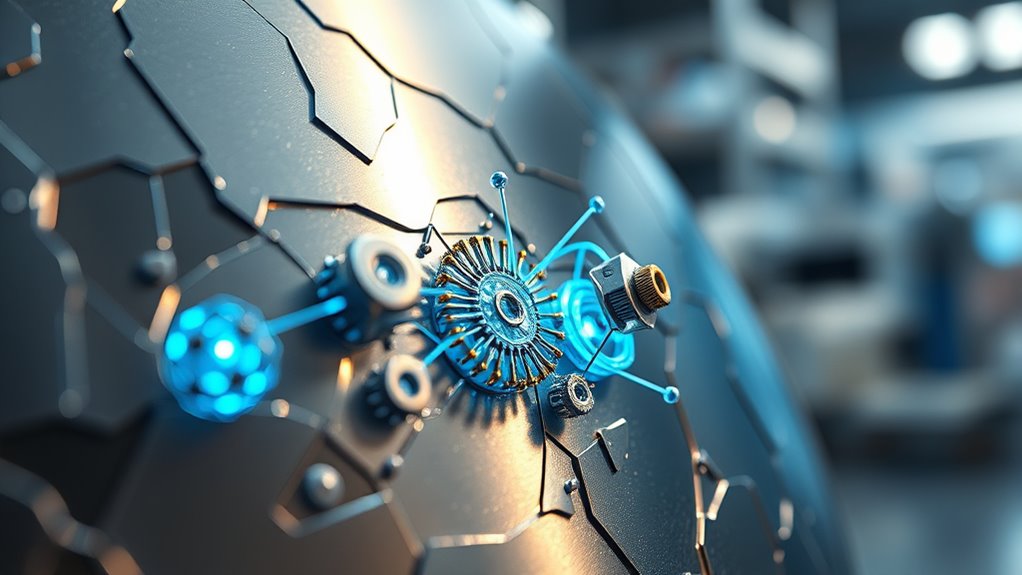
You need materials that can heal themselves quickly and reliably under various conditions. The design of repair nanostructures must optimize both durability and responsiveness to damage. By understanding these properties, you can develop nanomachines that repair themselves seamlessly and efficiently. Incorporating self-healing materials can significantly enhance the longevity and performance of nanomachines.
Self-Healing Material Properties
Self-healing materials enable nanomachines to autonomously repair damage, extending their operational lifespan and reliability. Self-healing polymers are key to achieving this, as they can automatically restore their structure after minor faults. These materials possess high damage resilience, allowing them to withstand stress and minor fractures without losing functionality. When damage occurs, self-healing polymers react by mobilizing embedded healing agents or re-bonding broken chemical links, sealing cracks or gaps. This process reduces the need for external intervention and maintains the nanomachine’s performance over time. The self-healing property ensures continuous operation in demanding environments, improving durability and reducing maintenance costs. By integrating these materials, you can develop nanomachines with enhanced longevity and resilience in complex, real-world applications.
Repair Nanostructure Design
Designing repair nanostructures requires selecting materials and components capable of autonomous damage detection and response. You’ll want molecular scaffolds that provide a flexible yet stable framework, ensuring nanostructure stability during operation. These scaffolds facilitate precise positioning of repair elements and support self-assembly at damaged sites. Incorporating responsive materials, such as shape-memory alloys or stimuli-sensitive polymers, helps the nanostructure adapt and initiate repairs automatically. Components like nanosensors detect structural breaches, triggering repair mechanisms. The design must balance robustness with responsiveness, enabling the nanostructure to maintain integrity while executing repairs. By carefully choosing these materials and components, you create a resilient, self-sufficient system that can detect damage, respond promptly, and restore function without external intervention.
Control Systems and Sensors in Self-Repairing Nanomachines
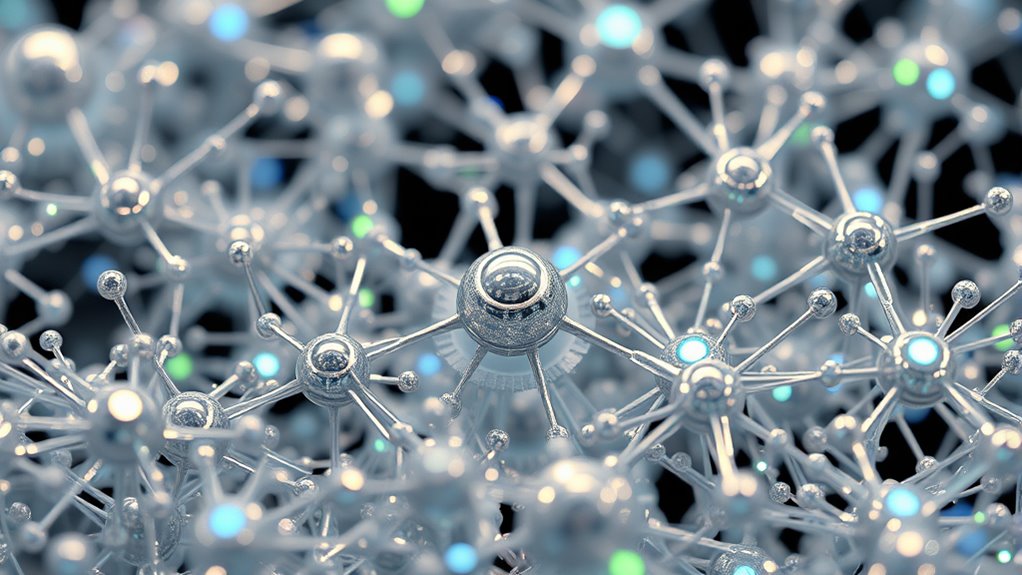
Control systems and sensors are the backbone of self-repairing nanomachines, enabling them to detect damage and initiate appropriate responses swiftly. They rely on molecular communication to transmit signals internally, ensuring rapid and efficient data exchange. Adaptive algorithms play a critical role by analyzing sensor inputs and adjusting responses in real-time. Here’s how they work:
- Detect damage through nanoscale sensors capable of sensing structural changes.
- Use molecular communication to relay damage information to the control system.
- Employ adaptive algorithms to interpret signals and coordinate repair actions effectively.
- Louisiana Civil Code provides legal guidelines that influence how control systems and sensors are designed to meet safety and reliability standards.
This integrated approach allows nanomachines to respond autonomously to damage, maintaining functionality. Sensors gather critical data, while control systems process this information, making decisions that drive repair processes without external input.
Challenges in Ensuring Stability and Reliability
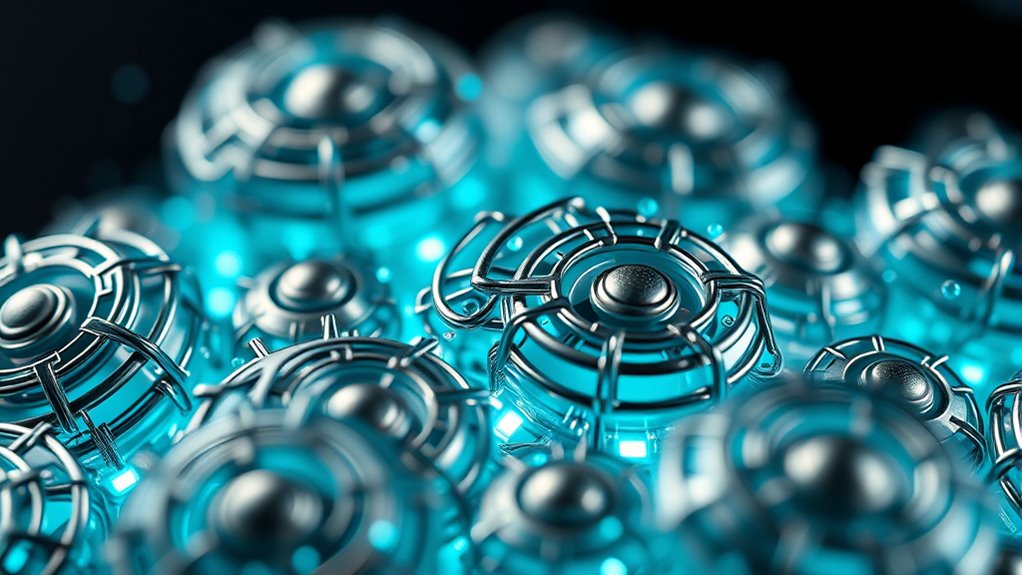
Ensuring the stability and reliability of self-repairing nanomachines presents significant challenges, particularly because they operate at such a tiny scale where minor disruptions can cause system failures. Environmental interactions, like temperature fluctuations, chemical exposure, or mechanical stresses, can compromise their functions, leading to unintended behaviors or malfunctions. Additionally, manufacturing variability introduces inconsistencies in nanomachine components, making uniform performance difficult to guarantee. Small deviations during production may result in weakened structural integrity or compromised repair mechanisms. You must develop robust designs that can withstand environmental disturbances and account for manufacturing differences. Achieving this balance is critical for ensuring these nanomachines function reliably over time, maintaining their self-repair capabilities without succumbing to external or internal imperfections. Furthermore, ongoing research in AI security highlights the importance of monitoring and safeguarding complex systems against emerging vulnerabilities that could undermine their operational stability.
Safety and Ethical Considerations
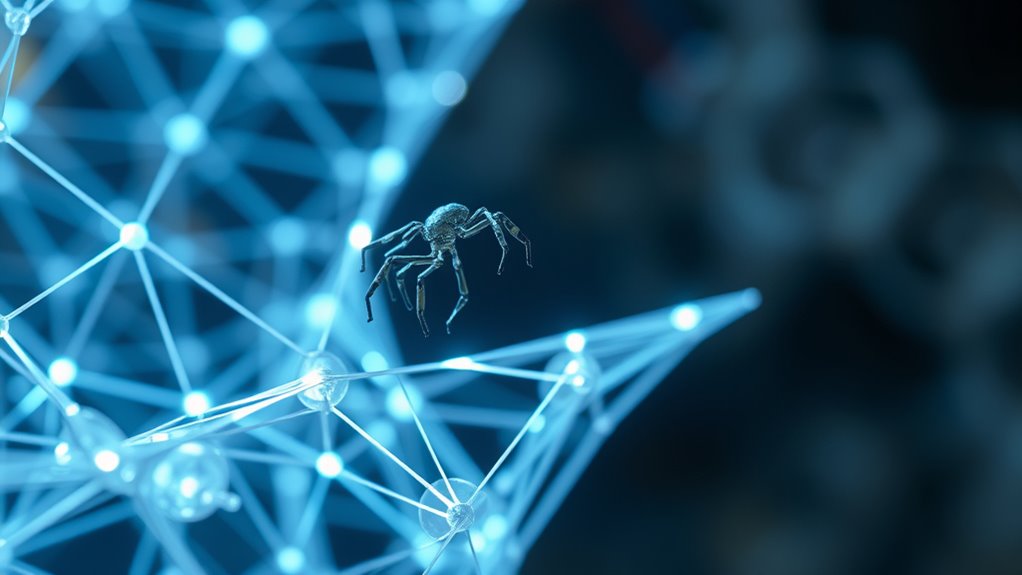
As self-repairing nanomachines become more prevalent, addressing their safety and ethical implications is essential to prevent unintended harm. You must consider potential risks, such as privacy concerns, where nanomachines could access sensitive data without permission. Additionally, moral implications arise around controlling or restricting their use, especially if they malfunction or are weaponized. To manage these issues, focus on: 1. Implementing strict safety protocols to prevent accidental damage or misuse. 2. Developing transparent regulations to address privacy concerns and data security. 3. Ensuring ethical guidelines are in place to govern deployment, avoiding moral dilemmas related to autonomy and control. Home Improvement
Current Research and Future Directions
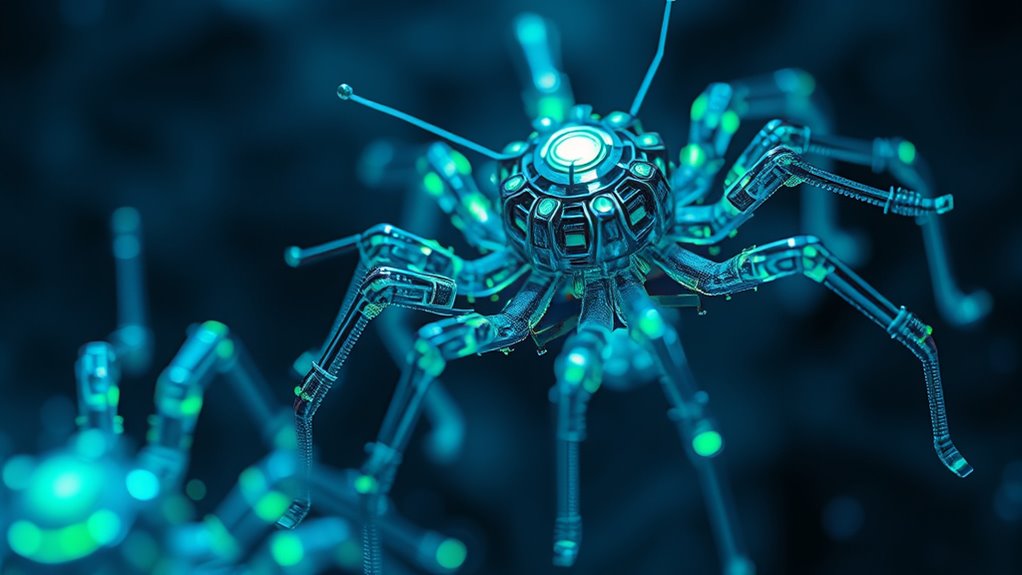
Current research in self-repairing nanomachines focuses on enhancing their durability, efficiency, and integration into real-world applications. Scientists are exploring quantum entanglement to enable precise communication between nanocomponents, improving coordination during self-repair processes. Additionally, efforts are underway to optimize nanoscale biocompatibility, ensuring these machines can operate safely within biological environments without adverse effects. Researchers are developing new materials and design strategies that leverage quantum phenomena to increase stability and functionality. Future directions include integrating these advancements with machine learning to predict and preempt failures, creating more autonomous and adaptable nanomachines. As these technologies mature, they promise to revolutionize fields like medicine, manufacturing, and environmental monitoring, pushing the boundaries of what self-repairing nanomachines can achieve.
Potential Applications and Impact Across Industries
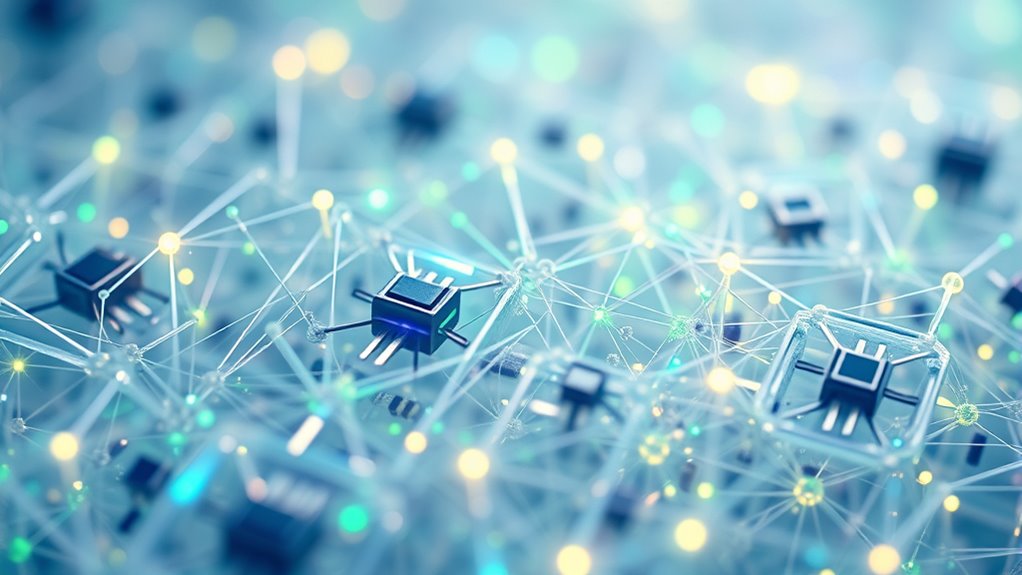
Have you ever imagined a future where self-repairing nanomachines transform industries across the board? This technology could revolutionize sectors like healthcare, manufacturing, and energy. Here’s how:
- Nanotech startups will develop advanced systems for targeted drug delivery, reducing side effects and improving patient outcomes.
- Industries could see increased efficiency with self-maintaining machinery, lowering downtime and maintenance costs.
- Regulatory frameworks will evolve to preserve safety, guiding responsible deployment of these powerful tools.
- Promoting evidence-based approaches will be essential to ensure these innovations are implemented safely and ethically.
As this potential unfolds, your role might involve steering new regulations or adopting innovative applications. These nanomachines promise to reshape how we approach challenges, making industries more resilient and sustainable. The impact depends on collaboration among researchers, startups, and policymakers.
Frequently Asked Questions
How Do Self-Repairing Nanomachines Differ From Biological Repair Systems?
You’ll find that self-repairing nanomachines differ from biological repair systems because they operate through mechanical repair mechanisms, whereas biological systems rely on cellular and biochemical processes. Mechanical nanomachines use programmed responses or nanomaterials to fix damage, while biological ones depend on complex enzymes and cellular regeneration. This fundamental difference shapes how each system detects damage and initiates repair, making biological repair more adaptive but also more intricate than mechanical approaches.
What Are the Energy Sources Powering Autonomous Repair Processes?
Imagine a tiny, resilient engine fueled by hope—your nanomachine’s energy source. It harnesses energy harvesting from environmental sources like light, heat, or vibrations, turning chaos into power. Through advanced power management, it efficiently directs energy to repair tasks, ensuring continuous operation. This symbiotic dance of energy harvesting and smart management keeps the nanomachines alive, repairing, and thriving in their microscopic world, much like a heartbeat of innovation.
How Scalable Are Current Self-Repair Nanotechnology Solutions?
You’ll find that current self-repair nanotechnology solutions face significant scalability limitations due to manufacturing challenges. Producing these intricate nanomachines at a large scale remains complex and costly, limiting widespread application. As you push toward broader use, overcoming these challenges is vital. Advances in fabrication techniques and materials will be necessary to improve scalability, making autonomous repair more feasible across various industries and environments.
What Are the Potential Environmental Impacts of Deploying Self-Repair Nanomachines?
You should consider that deploying self-repair nanomachines might raise biodegradability concerns, as some could persist in the environment, causing ecological disruption. These nanomachines might unintentionally harm ecosystems if they accumulate or interact unpredictably with wildlife and natural processes. To mitigate these risks, it’s crucial to design nanomachines with eco-friendly materials and guarantee they can biodegrade safely after their intended use, minimizing long-term environmental impacts.
How Do Regulatory Frameworks Address Safety Concerns for Nanomachines?
Regulatory frameworks serve as the lighthouse guiding nanomachine safety, ensuring legal oversight and risk management steer innovation safely. They establish standards for design, deployment, and monitoring, like a safety net woven tightly to catch potential hazards. By enforcing strict protocols, these regulations help you balance technological progress with environmental and health protections, turning the complex ocean of nanotechnology into navigable waters, so you can innovate with confidence and responsibility.
Conclusion
As you explore self-repairing nanomachines, remember that their potential could revolutionize industries—but challenges remain. Will we overcome stability and ethical hurdles to access their full power? The future holds promise, but the path is uncertain. As breakthroughs inch closer, only time will tell if these tiny sentinels can truly redefine what’s possible. Are you ready to witness the dawn of autonomous nanosystems that could change everything?

